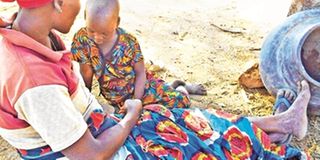In remote villages, the real problem is poverty

Living in a remote village in Singida, Monica Ezekiel struggles to provide for her children.
What you need to know:
Families living in villages in Tanzania suffer acute poverty
On October 17 (two days from today), the world will commemorate international Day of poverty eradication. This year, Sound Living traveled to a remote village in Singida region where our writer got to witness firsthand the level of poverty that still persists.
It is 12 noon and the sun has reached its highest point, as I walk towards few neighborhood houses scattered in a remote village I could sense the smell of food coming from numerous homes that surrounded the neighbourhood. However, when I arrived at Monica Ezekiel’s house, the case was different; the appetizing aroma that had engulfed the air had soon vanished, what pervaded the atmosphere was a stench of decay from the mud house in which she dwelt.
Sitting on the ground under a tree, outside her one old bedroom mud house in Masimba village, in Iramba district, Singida is Monica, she is not alone; with her is her youngest daughter who seems to be in deep thoughts that can be reflected from her facial expression.
After spending hours looking for water, this is the only time she gets to rest before she starts to prepare an evening meal for her family. “I am so tired, I was up since 4 am fetching water from a spring hole. It has taken me almost six hours to fill all my buckets. Because the spring holes are mostly dry, once you get to the water source, you should expect to spend even more time waiting in line,” she sadly explains.
The 38 year old mother of five from two different men is currently raising her children alone after she was separated from her second husband two years ago. Coming from a poor family, she never had an opportunity to go to school because her parents couldn’t afford to pay for her school expenses.
She openly admits that poverty is now starting to take its toll on her children, especially her eldest son. Monica says her son has become a village boy with no future after he had completed form four and failed to get money for school fees to join a college he had applied to.
“if only my son would have managed to get the college fee, I am sure he would have studied hard and helped us in the future. But the question is; where would we get the Sh1million needed as college fees for a college he has applied to? it’s not possible for people like us who are struggling to make ends meet,” she lamented.
With the Sh5000 she earns per day from her business of selling tomato’s, Monica is able to feed her children but because the amount she earns isn’t enough, they are forced to eat two meals per day or even one if things don’t go well with her business.
“What I earn is not enough to put food on the table for my children, so what I do is try to make sure we have at least two meals per day; breakfast at 10am and in the evening we eat our second meal. But that is on a good day, if things don’t go particularly well at work, then we end up eating one meal per day,” she says.
Monica sees little hope for her children whom she wishes would get to finish their education and break the poverty cycle in her family. “it’s hard to predict the future unless my children finish their education and get good jobs, but I don’t see that happening anytime soon. No parents would wish to see their children live the kind of life that my children endure but there is nothing we can do about it. Reality is things are hard, and they keep getting tougher each day,” the struggling mother says.
Poverty is a global problem
Monica’s family is one among thousands of families living in poverty throughout the world and her story represents the ordeal that many of these families face each day as they struggle to make a decent living in a bid to end the poverty cycle.
The government and other private institutions both local and international have spent millions, if not billions of shillings on families like Monica’s to empower them and end the cycle of poverty that is deep rooted in many Tanzanian family, especially those living in remote villages. However, the programs clearly haven't been effective enough in getting majority of poor communities out of poverty.
Presenting the national five year development plan 2016/17 – 2020/21 last year at the National Assembly in June, Minister of Finance and Planning Dr. Philip Mpango, said people living in rural areas, majority of them live in acute poverty and that their ability to get basic needs in very low.
He mentioned five regions leading in poverty based on the 2012 Population and Housing Census and the Household Budget survey; these include Kigoma where 48.9 per cent of its population is said to live below the poverty line and Geita, whose population of the poor is 43.7 per cent. Other poorest regions include: Kagera (39.3 per cent), Singida (38.2 per cent) and Mwanza (35.3 per cent) with per capita income dropping from $1,047 (Sh2.3 million at the prevailing exchange rate) in 2014 to $ 966.5(Sh2.2 million) in 2015.
Global efforts have been made by the United Nations to recognise the resilience and courage of families living in poverty throughout the world and the importance of reaching out to the poorest and building an alliance with citizens from all backgrounds to end poverty.
That’s why each year on October 17 the world commemorates the International Day of poverty eradication, with this year’s theme - Answering the Call of October 17 to end poverty: A path toward peaceful and inclusive societies, reminding us of the importance of the values of dignity, solidarity and voice underscored in the call to action to fight to end poverty everywhere.
According to World Bank, Tanzania has sustained relatively high economic growth over the last decade, averaging 6–7% a year. But while its poverty rate has declined, its absolute number of poor has not because of its high population growth rate. The country's overall population is about 55 million (2016).
World Bank Tanzania Mainland Poverty Assessment 2015 report shows that until 2007, the poverty rate in Tanzania remained stagnant at around 34 percent despite a strong growth at an annualised rate of approximately 7 percent. This apparent disconnect between growth and poverty reduction has raised concerns among policy makers and researchers, leading to an agreement that this mismatch needed to be addressed with a sense of urgency.
However the National Strategy for Growth and Reduction of Poverty (MKUKUTA) over the past few years has given high priority to eradicating extreme poverty and promoting broad-based growth. The MKUKUTA II assessment report 2010 - 2015, which takes stock of the achievements and challenges of MKUKUTA II, showed that during the period under review, GDP in real terms grew by seven percent or above with the exception of 2012 where it grew by 5.1 percent.
“The GDP growth however has not reached MKUKUTA II target of achieving and maintaining an 8-10 percent growth necessary for eradicating absolute poverty by 2025. Income poverty starts to respond to economic growth. The proportion of Mainland population in basic needs poverty was 28.2 percent in 2011/12, down from 34.4 percent in 2007,” stated the report.
Since coming to office, President Magufuli has reoriented public expenditure toward development spending, reducing recurrent expenditure significantly, and intensifying efforts to mobilize domestic revenue. Government spending was cut back, and a cap put in place on the salaries of executive officers. Measures were introduced to control tax exemptions.
But as seen in Singida region, the level of poverty remains excruciatingly high. Parents and guardians are not able to afford basic needs to their families, all this owing to the sorry state of the economy.
World Bank poverty assessment recommends promoting faster economic growth in labor intensive sectors, including agriculture where three-quarters of Tanzanians continue to be employed.
“Reducing population growth and the country’s high fertility rate on average, five children per woman by empowering them through education and employment support and with family planning services can stimulate per capita economic growth further,” stated the MKUKUTA II report.
Social Context
According to World Bank, although Tanzania's poverty rate fell from 60 per cent in 2007 to an estimated 47 per cent in 2016, based on the US$1.90 (around Sh4,000) per day global poverty line, about 12 million Tanzanians still live in extreme poverty on earnings of less than US$0.60 (around Sh1,300) per day. Many others live just above the poverty line and risk falling back into poverty in the event of socio-economic shocks. Universal education, and the waiving of fees for primary and secondary schools, has drastically increased primary school enrolment.
With approximately 800,000 youth entering the labor force every year, nurturing a vibrant private sector to provide productive jobs is critically important.




